2019 CHRYSLER 300 check oil
[x] Cancel search: check oilPage 352 of 492
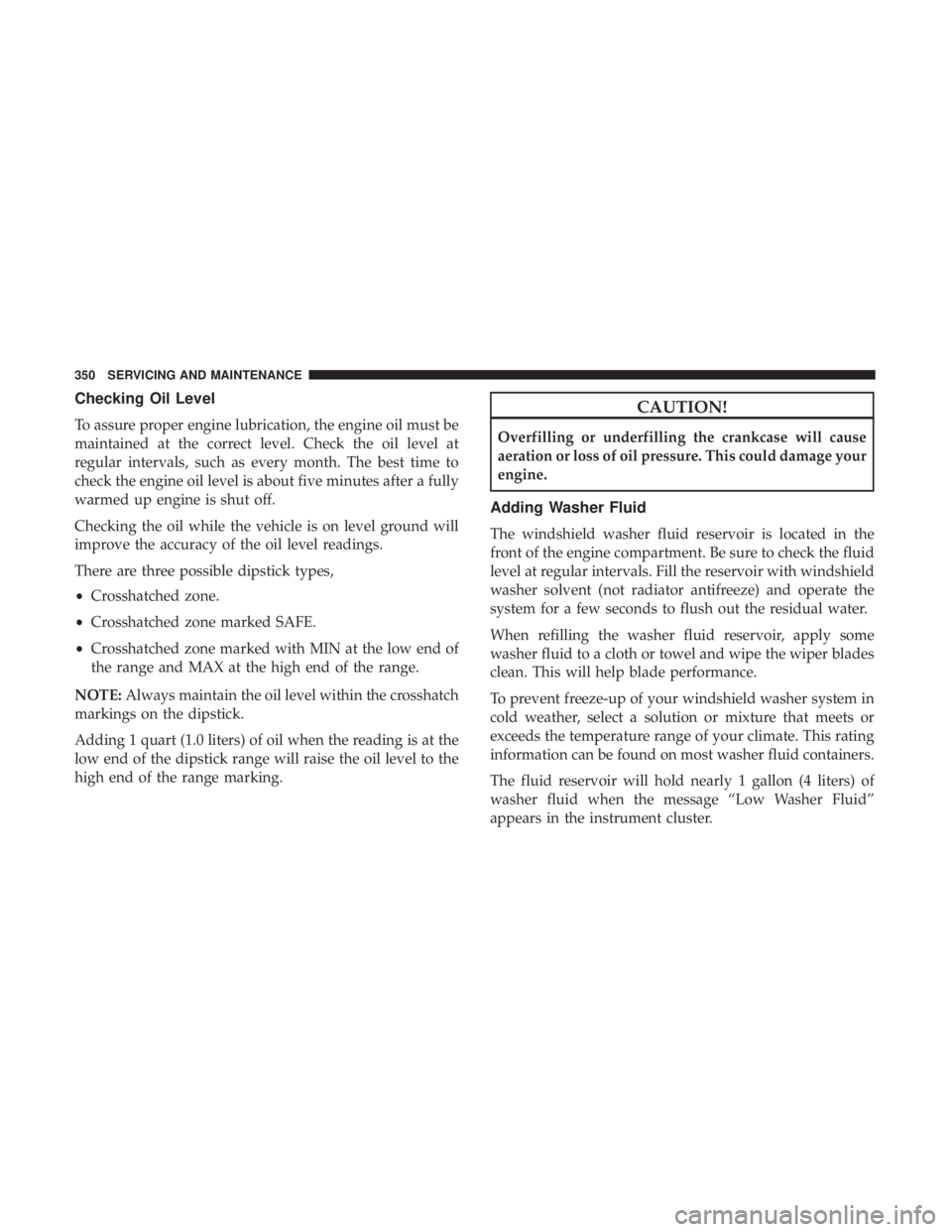
Checking Oil Level
To assure proper engine lubrication, the engine oil must be
maintained at the correct level. Check the oil level at
regular intervals, such as every month. The best time to
check the engine oil level is about five minutes after a fully
warmed up engine is shut off.
Checking the oil while the vehicle is on level ground will
improve the accuracy of the oil level readings.
There are three possible dipstick types,
•Crosshatched zone.
• Crosshatched zone marked SAFE.
• Crosshatched zone marked with MIN at the low end of
the range and MAX at the high end of the range.
NOTE: Always maintain the oil level within the crosshatch
markings on the dipstick.
Adding 1 quart (1.0 liters) of oil when the reading is at the
low end of the dipstick range will raise the oil level to the
high end of the range marking.
CAUTION!
Overfilling or underfilling the crankcase will cause
aeration or loss of oil pressure. This could damage your
engine.
Adding Washer Fluid
The windshield washer fluid reservoir is located in the
front of the engine compartment. Be sure to check the fluid
level at regular intervals. Fill the reservoir with windshield
washer solvent (not radiator antifreeze) and operate the
system for a few seconds to flush out the residual water.
When refilling the washer fluid reservoir, apply some
washer fluid to a cloth or towel and wipe the wiper blades
clean. This will help blade performance.
To prevent freeze-up of your windshield washer system in
cold weather, select a solution or mixture that meets or
exceeds the temperature range of your climate. This rating
information can be found on most washer fluid containers.
The fluid reservoir will hold nearly 1 gallon (4 liters) of
washer fluid when the message “Low Washer Fluid”
appears in the instrument cluster.
350 SERVICING AND MAINTENANCE
Page 358 of 492
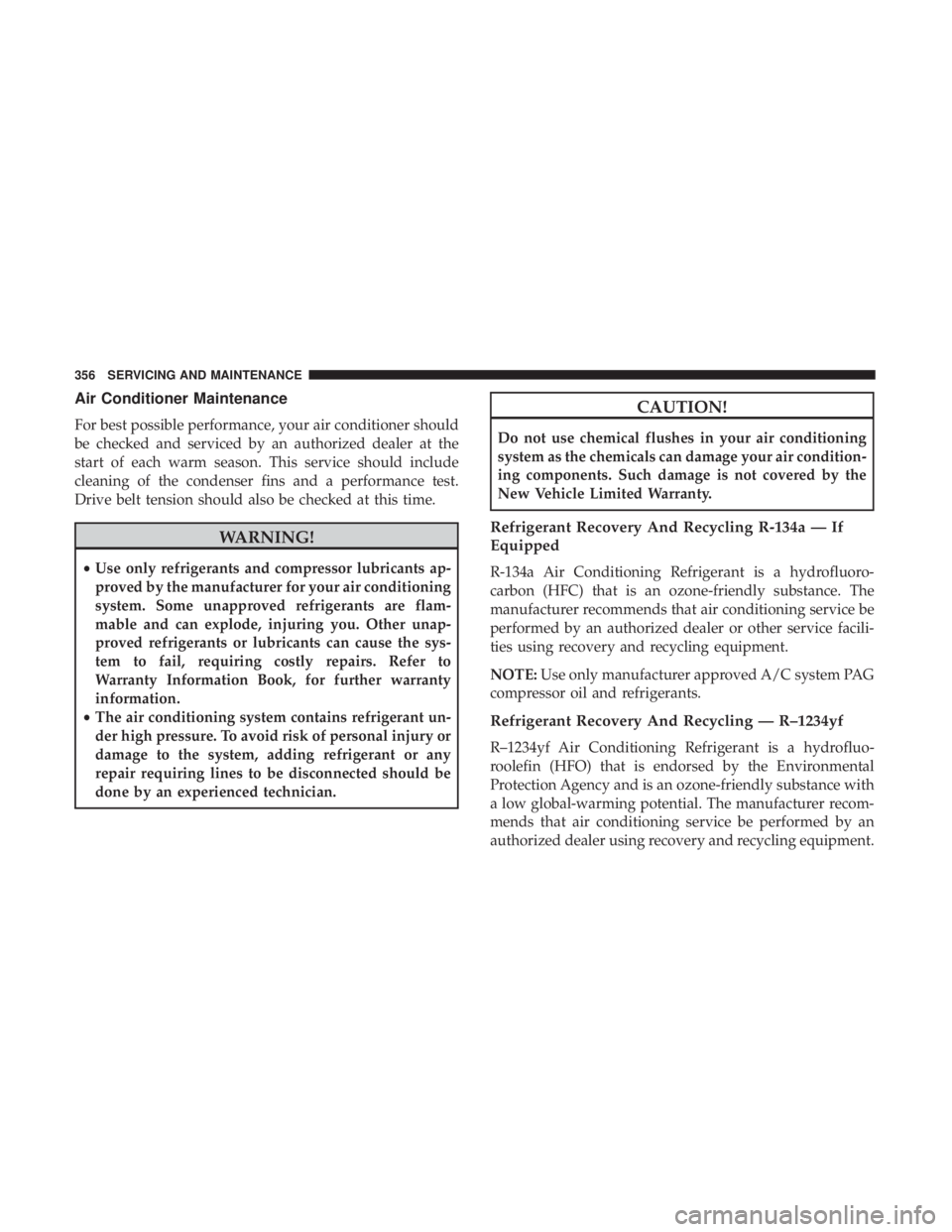
Air Conditioner Maintenance
For best possible performance, your air conditioner should
be checked and serviced by an authorized dealer at the
start of each warm season. This service should include
cleaning of the condenser fins and a performance test.
Drive belt tension should also be checked at this time.
WARNING!
•Use only refrigerants and compressor lubricants ap-
proved by the manufacturer for your air conditioning
system. Some unapproved refrigerants are flam-
mable and can explode, injuring you. Other unap-
proved refrigerants or lubricants can cause the sys-
tem to fail, requiring costly repairs. Refer to
Warranty Information Book, for further warranty
information.
• The air conditioning system contains refrigerant un-
der high pressure. To avoid risk of personal injury or
damage to the system, adding refrigerant or any
repair requiring lines to be disconnected should be
done by an experienced technician.
CAUTION!
Do not use chemical flushes in your air conditioning
system as the chemicals can damage your air condition-
ing components. Such damage is not covered by the
New Vehicle Limited Warranty.
Refrigerant Recovery And Recycling R-134a — If
Equipped
R-134a Air Conditioning Refrigerant is a hydrofluoro-
carbon (HFC) that is an ozone-friendly substance. The
manufacturer recommends that air conditioning service be
performed by an authorized dealer or other service facili-
ties using recovery and recycling equipment.
NOTE: Use only manufacturer approved A/C system PAG
compressor oil and refrigerants.
Refrigerant Recovery And Recycling — R–1234yf
R–1234yf Air Conditioning Refrigerant is a hydrofluo-
roolefin (HFO) that is endorsed by the Environmental
Protection Agency and is an ozone-friendly substance with
a low global-warming potential. The manufacturer recom-
mends that air conditioning service be performed by an
authorized dealer using recovery and recycling equipment.
356 SERVICING AND MAINTENANCE
Page 372 of 492
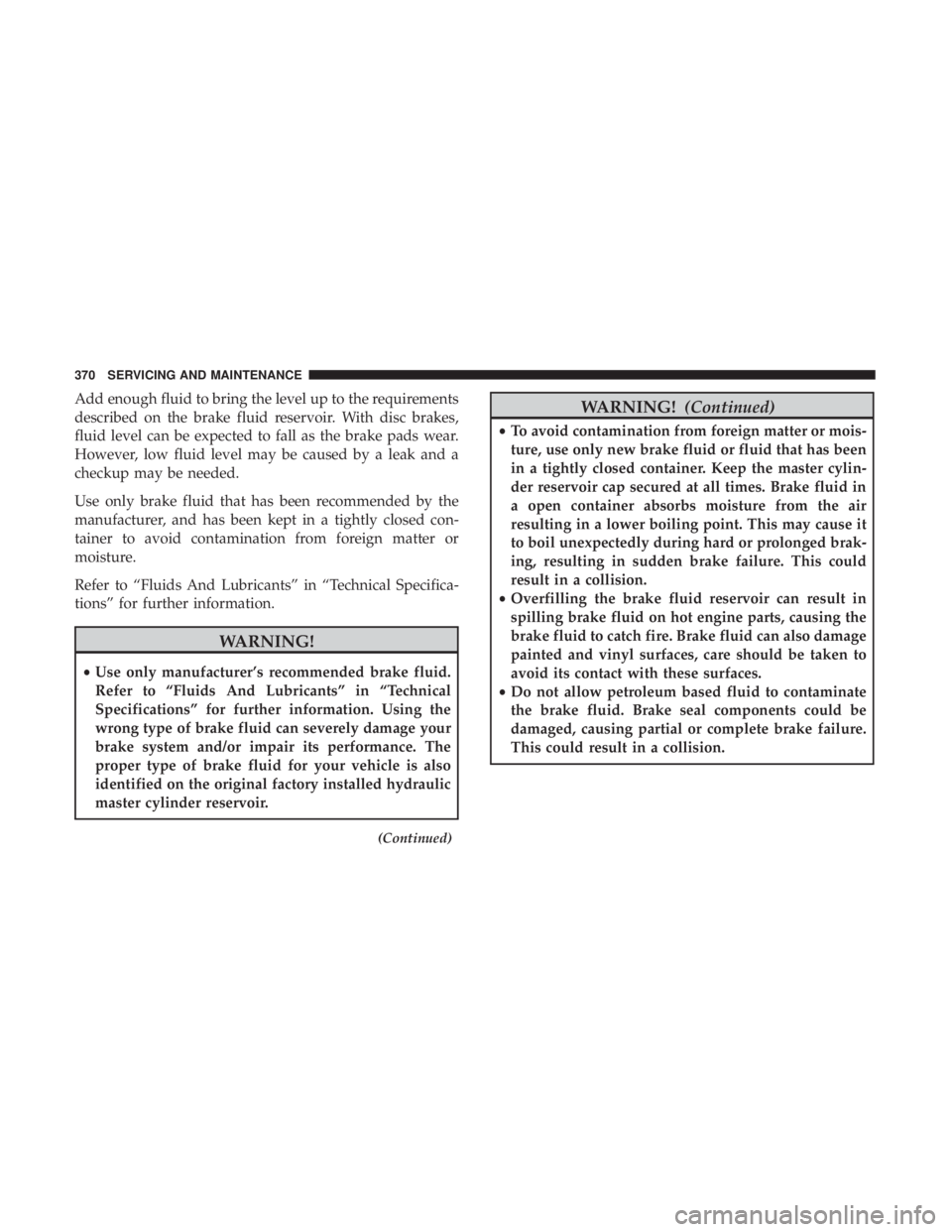
Add enough fluid to bring the level up to the requirements
described on the brake fluid reservoir. With disc brakes,
fluid level can be expected to fall as the brake pads wear.
However, low fluid level may be caused by a leak and a
checkup may be needed.
Use only brake fluid that has been recommended by the
manufacturer, and has been kept in a tightly closed con-
tainer to avoid contamination from foreign matter or
moisture.
Refer to “Fluids And Lubricants” in “Technical Specifica-
tions” for further information.
WARNING!
•Use only manufacturer’s recommended brake fluid.
Refer to “Fluids And Lubricants” in “Technical
Specifications” for further information. Using the
wrong type of brake fluid can severely damage your
brake system and/or impair its performance. The
proper type of brake fluid for your vehicle is also
identified on the original factory installed hydraulic
master cylinder reservoir.
(Continued)
WARNING! (Continued)
•To avoid contamination from foreign matter or mois-
ture, use only new brake fluid or fluid that has been
in a tightly closed container. Keep the master cylin-
der reservoir cap secured at all times. Brake fluid in
a open container absorbs moisture from the air
resulting in a lower boiling point. This may cause it
to boil unexpectedly during hard or prolonged brak-
ing, resulting in sudden brake failure. This could
result in a collision.
• Overfilling the brake fluid reservoir can result in
spilling brake fluid on hot engine parts, causing the
brake fluid to catch fire. Brake fluid can also damage
painted and vinyl surfaces, care should be taken to
avoid its contact with these surfaces.
• Do not allow petroleum based fluid to contaminate
the brake fluid. Brake seal components could be
damaged, causing partial or complete brake failure.
This could result in a collision.
370 SERVICING AND MAINTENANCE
Page 374 of 492

CAUTION!
If a transmission fluid leak occurs, visit an authorized
dealer immediately. Severe transmission damage may
occur. An authorized dealer has the proper tools to
adjust the fluid level accurately.
Fluid And Filter Changes
Under normal operating conditions, the fluid installed at
the factory will provide satisfactory lubrication for the life
of the vehicle.
Routine fluid and filter changes are not required. However,
change the fluid and filter if the fluid becomes contami-
nated (with water, etc.), or if the transmission is disas-
sembled for any reason.
All Wheel Drive (AWD) — If Equipped
The all wheel drive system consists of a transfer case and
front differential. The exterior surface of these components
should be inspected for evidence of fluid leaks. Confirmed
leaks should be repaired as soon as possible.The transfer case fluid fill/inspection plug is located in the
middle of the rear housing. To inspect the transfer case
fluid level, remove the fill/inspection plug. The fluid level
should be even with the bottom of the hole. Use this plug
to add fluid as required.
The front differential fill plug is located on the outer cover
near the halfshaft attachment. To inspect the differential
fluid level, remove the fill plug. The fluid level should be
even with or slightly below the bottom of the hole.
Fluid Changes
Refer to “Scheduled Servicing” in “Servicing And Mainte-
nance” for the proper maintenance intervals.
Rear Axle
For normal service, periodic fluid level checks are not
required. When the vehicle is serviced for other reasons the
exterior surfaces of the axle assembly should be inspected.
If gear oil leakage is suspected inspect the fluid level. Refer
to “Fluids And Lubricants” in “Technical Specifications”
for further information.
372 SERVICING AND MAINTENANCE
Page 408 of 492

In the event power assist is lost for any reason (for
example, repeated brake applications with the engine
OFF), the brakes will still function. The effort required to
brake the vehicle will be much greater than that required
with the power system operating.
WHEEL AND TIRE TORQUE SPECIFICATIONS
Proper lug nut/bolt torque is very important to ensure that
the wheel is properly mounted to the vehicle. Any time a
wheel has been removed and reinstalled on the vehicle, the
lug nuts/bolts should be torqued using a properly cali-
brated torque wrench using a high quality six sided (hex)
deep wall socket.
Torque Specifications
Lug Nut/BoltTorque **Lug Nut/Bolt
Size Lug Nut/Bolt
Socket Size
130 Ft-Lbs (176 N·m) M14 x 1.50 22 mm
**Use only your authorized dealer recommended lug nuts/
bolts and clean or remove any dirt or oil before tightening. Inspect the wheel mounting surface prior to mounting the
tire and remove any corrosion or loose particles.
Tighten the lug nuts/bolts in a star pattern until each
nut/bolt has been tightened twice. Ensure that the socket is
fully engaged on the lug nut/bolt (do not insert it half-
way).
NOTE:
If in doubt about the correct tightness, have them
checked with a torque wrench by your authorized dealer or
service station.
Wheel Mounting Surface
406 TECHNICAL SPECIFICATIONS
Page 476 of 492
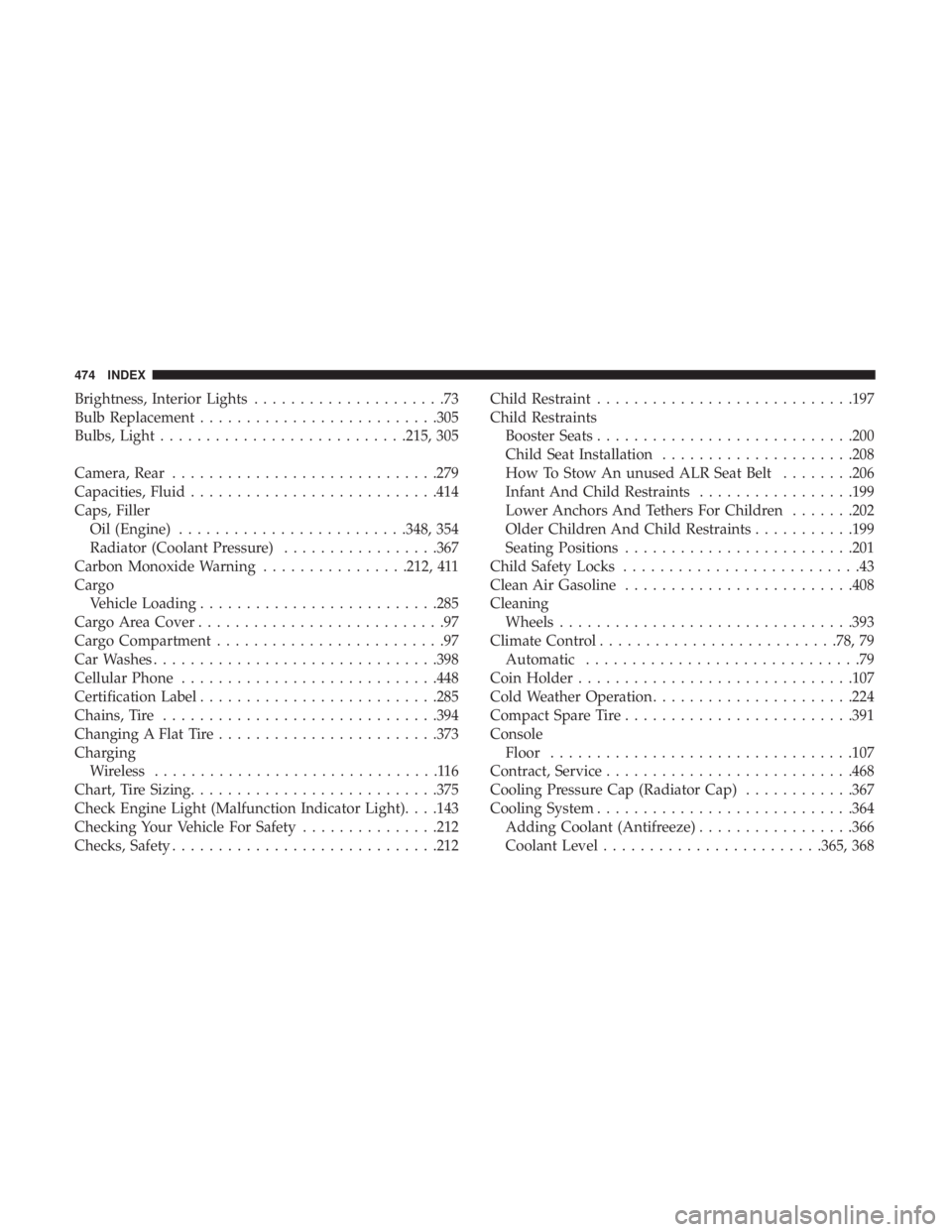
Brightness, Interior Lights.....................73
Bulb Replacement ......................... .305
Bulbs, Light .......................... .215, 305
Camera, Rear ............................ .279
Capacities, Fluid .......................... .414
Caps, Filler Oil (Engine) ........................ .348, 354
Radiator (Coolant Pressure) .................367
Carbon Monoxide Warning ................212, 411
Cargo Vehicle Loading ......................... .285
Cargo Area Cover ...........................97
Cargo Compartment .........................97
Car Washes .............................. .398
Cellular Phone ........................... .448
Certification Label ......................... .285
Chains, Tire ............................. .394
Changing A Flat Tire ....................... .373
Charging Wireless ...............................116
Chart, Tire Sizing .......................... .375
Check Engine Light (Malfunction Indicator Light). . . .143
Checking Your Vehicle For Safety ...............212
Checks, Safety ............................ .212Child Restraint
........................... .197
Child Restraints Booster Seats ........................... .200
Child Seat Installation .....................208
How To Stow An unused ALR Seat Belt ........206
Infant And Child Restraints .................199
Lower Anchors And Tethers For Children .......202
Older Children And Child Restraints ...........199
Seating Positions ........................ .201
Child Safety Locks ..........................43
Clean Air Gasoline ........................ .408
Cleaning Wheels ............................... .393
Climate Control ......................... .78, 79
Automatic ..............................79
Coin Holder ............................. .107
Cold
Weather Operation ..................... .224
Compact Spare Tire ........................ .391
Console Floor ................................ .107
Contract, Service .......................... .468
Cooling Pressure Cap (Radiator Cap) ............367
Cooling System ........................... .364
Adding Coolant (Antifreeze) .................366
Coolant Level ....................... .365, 368
474 INDEX
Page 478 of 492
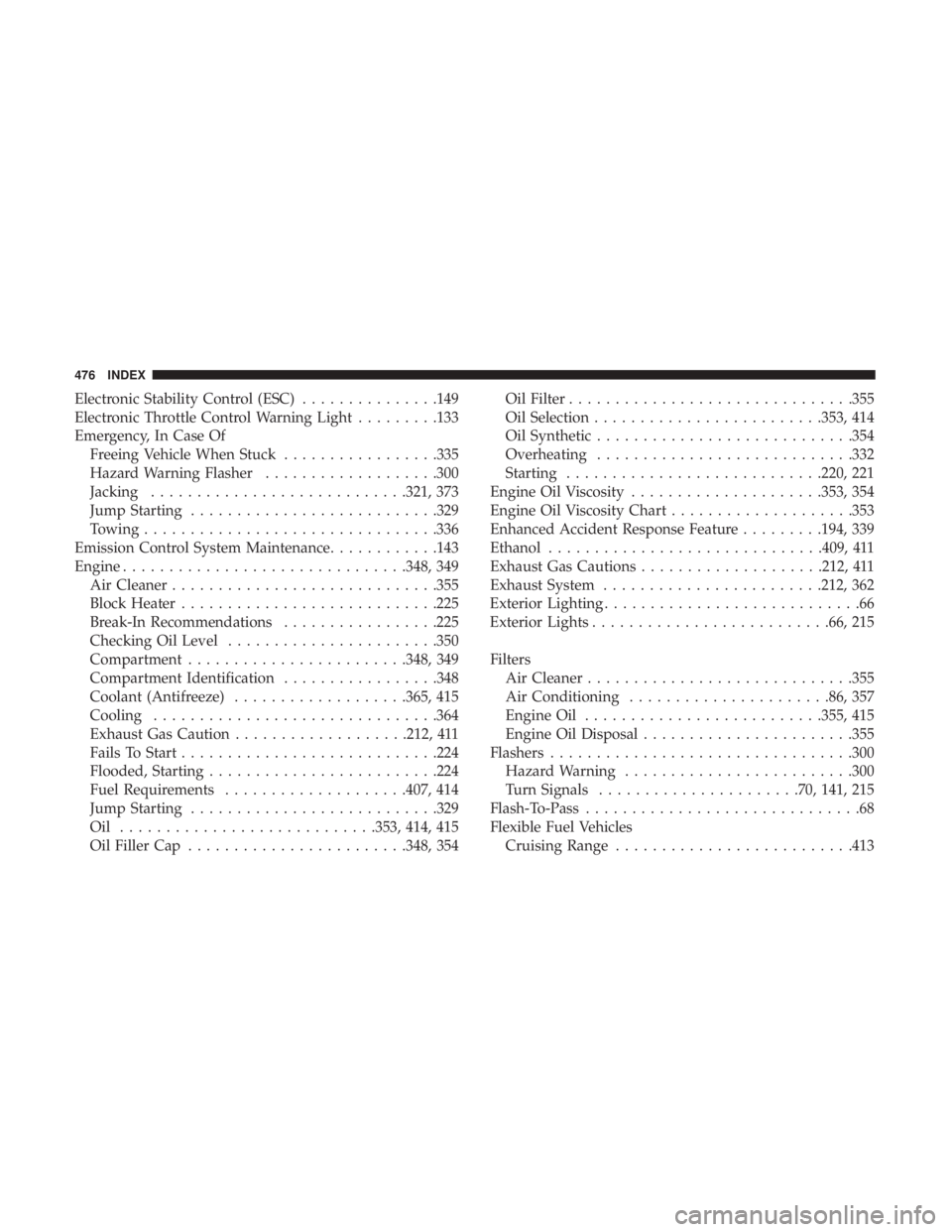
Electronic Stability Control (ESC)...............149
Electronic Throttle Control Warning Light .........133
Emergency, In Case Of Freeing Vehicle When Stuck .................335
Hazard Warning Flasher ...................300
Jacking ........................... .321, 373
Jump Starting .......................... .329
Towing ............................... .336
Emission Control System Maintenance ............143
Engine .............................. .348, 349
Air Cleaner ............................ .355
Block Heater ........................... .225
Break-In Recommendations .................225
Checking Oil Level ...................... .350
Compartment ....................... .348, 349
Compartment Identification .................348
Coolant (Antifreeze) ...................365, 415
Cooling .............................. .364
Exhaust Gas Caution ...................212, 411
Fails To Start ........................... .224
Flooded, Starting ........................ .224
Fuel Requirements ....................407, 414
Jump Starting .......................... .329
Oil ........................... .353, 414, 415
Oil Filler Cap ....................... .348, 354Oil Filter
.............................. .355
Oil Selection ........................ .353, 414
Oil Synthetic ........................... .354
Overheating ........................... .332
Starting ........................... .220, 221
Engine Oil Viscosity .....................353, 354
Engine Oil Viscosity Chart ....................353
Enhanced Accident Response Feature .........194, 339
Ethanol ............................. .409, 411
Exhaust Gas Cautions ................... .212, 411
Exhaust
System ....................... .212, 362
Exterior Lighting ............................66
Exterior Lights ......................... .66, 215
Filters Air Cleaner ............................ .355
Air Conditioning ..................... .86, 357
Engine Oil ......................... .355, 415
Engine Oil Disposal ...................... .355
Flashers ................................ .300
Hazard Warning ........................ .300
Turn Signals ..................... .70, 141, 215
Flash-To-Pass ..............................68
Flexible Fuel Vehicles Cruising Range ......................... .413
476 INDEX
Page 479 of 492
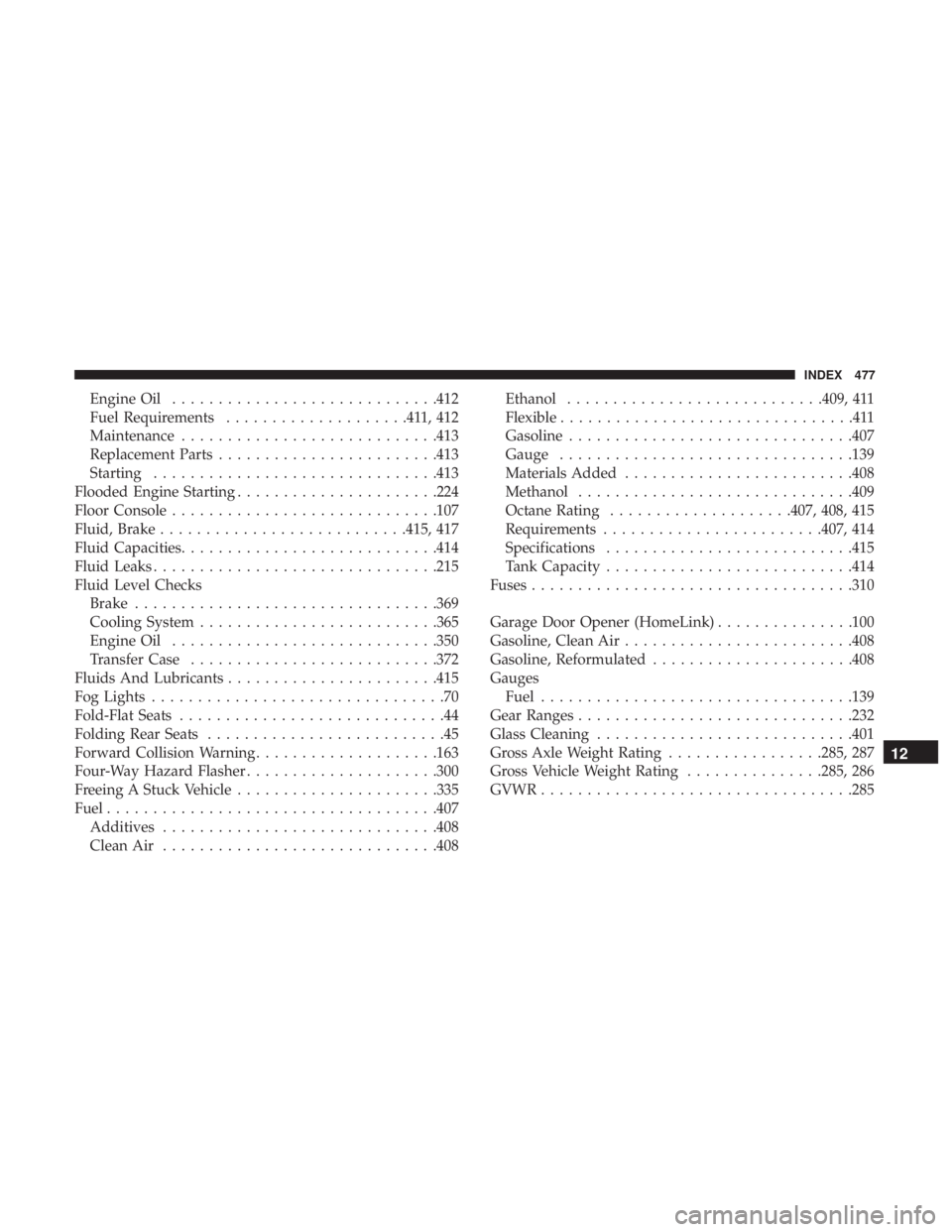
Engine Oil............................ .412
Fuel Requirements ....................411,412
Maintenance ........................... .413
Replacement Parts ....................... .413
Starting .............................. .413
Flooded Engine Starting ..................... .224
Floor Console ............................ .107
Fluid, Brake .......................... .415, 417
Fluid Capacities ........................... .414
Fluid Leaks .............................. .215
Fluid Level Checks Brake ................................ .369
Cooling System ......................... .365
Engine Oil ............................ .350
Transfer Case .......................... .372
Fluids And Lubricants ...................... .415
Fog Lights ................................70
Fold-Flat Seats .............................44
Folding Rear Seats ..........................45
Forward Collision Warning ....................163
Four-Way Hazard Flasher .....................300
Freeing A Stuck Vehicle ..................... .335
Fuel ................................... .407
Additives ............................. .408
Clean Air ............................. .408Ethanol
........................... .409, 411
Flexible ................................411
Gasoline .............................. .407
Gauge ............................... .139
Materials Added ........................ .408
Methanol ............................. .409
Octane Rating ....................407, 408, 415
Requirements ....................... .407, 414
Specifications .......................... .415
Tank Capacity .......................... .414
Fuses .................................. .310
Garage Door Opener (HomeLink) ...............100
Gasoline,
Clean Air ........................ .408
Gasoline, Reformulated ..................... .408
Gauges Fuel ................................. .139
Gear Ranges ............................. .232
Glass Cleaning ........................... .401
Gross Axle Weight Rating .................285, 287
Gross Vehicle Weight Rating ...............285, 286
GVWR ................................. .285
12
INDEX 477